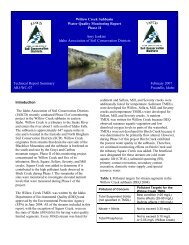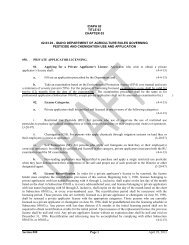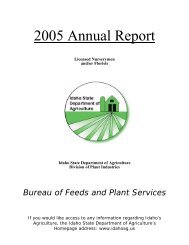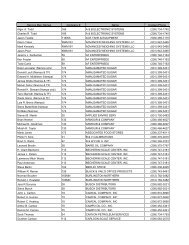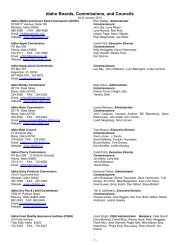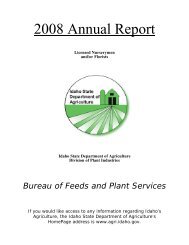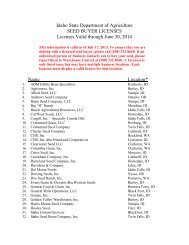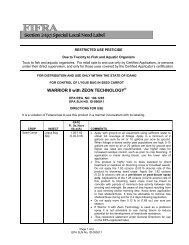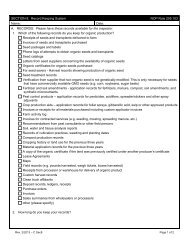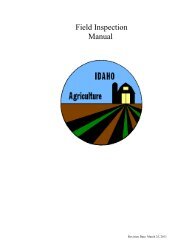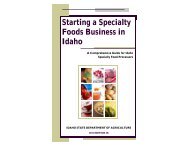COMPOUND DRC-1339 CONCENTRATE - STAGING AREAS - ID ...
COMPOUND DRC-1339 CONCENTRATE - STAGING AREAS - ID ...
COMPOUND DRC-1339 CONCENTRATE - STAGING AREAS - ID ...
You also want an ePaper? Increase the reach of your titles
YUMPU automatically turns print PDFs into web optimized ePapers that Google loves.
SUPPLEMENTAL LABELING<br />
<strong>COMPOUND</strong> <strong>DRC</strong>-<strong>1339</strong> <strong>CONCENTRATE</strong> - <strong>STAGING</strong> <strong>AREAS</strong> - <strong>ID</strong><br />
EPA SLN No. <strong>ID</strong>-050013<br />
EPA Registration Number 56228-30<br />
FOR DISTRIBUTION AND USE ONLY WITHIN <strong>ID</strong>AHO<br />
This product may be used to control American crows (Corvus brachyrhynchos) and European starlings (Sturnus vulgaris) in staging<br />
areas associated with urban roosts.<br />
THIS LABEL AND THE FEDERAL LABEL MUST BE IN POSSESSION OF THE USER AT THE TIME<br />
OF PESTIC<strong>ID</strong>E APPLICATION. READ THE ENTIRE LABEL AND THE ENTIRE FEDERAL LABEL.<br />
FOLLOW ALL APPLICABLE DIRECTIONS, RESTRICTIONS AND PRECAUTIONS FOUND ON<br />
EITHER LABEL.<br />
EPA Reg. No. 56228-30, EPA SLN No. <strong>ID</strong> 050013<br />
EPA Est. No. 56228-<strong>ID</strong>-1<br />
Net Contents: _______<br />
DIRECTIONS FOR USE<br />
It is a violation of Federal law to use this product in a manner inconsistent with its labeling.<br />
READ THIS LABEL:<br />
RESTRICTED USE PESTIC<strong>ID</strong>E<br />
DUE TO HIGH ACUTE INHALATION TOXICITY AND EYE AND SKIN<br />
CORROSIVENESS TO HUMANS; HIGH ACUTE TOXICITY TO NONTARGET<br />
BIRDS AND AQUATIC INVERTEBRATES; AND THE NEED FOR HIGHLY<br />
SPECIALIZED APPLICATOR TRAINING.<br />
Read the entire label and the label for EPA Registration Number 56228-30. This product must be<br />
used strictly in accordance with both labels’ precautionary statements and applicable use<br />
directions, as well as with all applicable State and Federal laws and regulations.<br />
Before using this product, contact the U.S. Fish and Wildlife Service and the applicable State<br />
wildlife agency and obtain all necessary kill or collecting permits.<br />
GENERAL INFORMATION:<br />
For sale and transfer to, and use only by, Certified Applicators, who are USDA<br />
APHIS personnel trained in bird control.<br />
This product contains a slow acting avicide which kills target birds in 1 to 3 days. As many types of<br />
nontarget bird species are potentially vulnerable to <strong>DRC</strong>-<strong>1339</strong>, it is necessary to use care and to follow<br />
the requirements of this label to minimize impacts to nontarget species.<br />
Page 1 of 6: SLN No. <strong>ID</strong>-050013
USE RESTRICTIONS:<br />
Baits made from Compound <strong>DRC</strong>-<strong>1339</strong> Concentrate-<strong>ID</strong> may only be used to control American crows<br />
(Corvus brachyrhynchos) and European starlings (Sturnus vulgaris), in noncrop staging areas associated<br />
with urban roosts. Baits may be applied in stubble fields, open grassy or bare-ground non-crop areas,<br />
rooftops, industrial and commercial structures, secured parking areas, or bait containers (see FEEDING<br />
STATION APPLICATION instructions below). DO NOT apply bait made from this product by air or<br />
by procedures not prescribed on this label.<br />
This product may only be used to make baits with rolled corn, rolled barley, brown rice, poultry pellets,<br />
whole corn, dry dog food, cull French fries, bread, or croutons unless prebait observations have<br />
demonstrated that these baits are not accepted by the target species or present undue risk to non-target<br />
animals. Other bait materials may only be used if it is demonstrated that they are preferred by the target<br />
species and the non-target risks are equal to or less than those for primary baits listed above. Baiting<br />
will be conducted following the instructions indicated on this label under BAIT PREPARATION.<br />
DO NOT use baits as food or feed. DO NOT apply this product in a manner that will contaminate food,<br />
feed or water. DO NOT harvest any crop for use as food or feed that has been contaminated with this<br />
product. DO NOT graze livestock or plant any rotational crop in treated noncrop areas or in crop areas<br />
that may have been contaminated by treated bait spilled from bait application containers for one year<br />
(365 days) following the last application of bait made from this product.<br />
DO NOT exceed a maximum single application rate of 0.1 lb (1.6 oz) of active ingredient per treated<br />
acre or a maximum cumulative application rate of 0.5 lb (8 oz) of active ingredient per treated acre in<br />
any year. An acre is approximately 43,560 feet square. See APPLICATION DIRECTIONS for<br />
information on acceptable bait material and the maximum amount of bait allowed per application per<br />
acre.<br />
DO NOT apply treated baits within 50 feet of bodies of water.<br />
Before baits made from this product are applied, sites that are to be treated must be observed for<br />
evidence of nontarget activity and must be prebaited (see specific instructions for these activities). DO<br />
NOT apply treated baits in locations where prebait has not been accepted well by target species or<br />
where nontarget wildlife have been observed to feed on prebait.<br />
Before undertaking any control operations with this product, local, State, and Federal Wildlife<br />
authorities will be consulted to ensure the use of this product presents no hazard to any Threatened or<br />
Endangered species. DO NOT apply bait(s) in areas where there is danger that Threatened or<br />
Endangered species will consume baits unless special precautions are taken to limit such exposures.<br />
Such precautions shall include observation of baited sites and hazing tactics to frighten away Threatened<br />
or Endangered species that otherwise might feed upon baits. The Threatened or Endangered species<br />
potentially at risk from use of this product is the BALD EAGLE (Haliaeetus leucocephalus).<br />
DO NOT use bait materials that resemble human foods in any areas accessible to children unless bait<br />
site is constantly monitored and attended by applicator.<br />
DO NOT apply baits made from this product in a way that will contact workers or other persons.<br />
When mixed in flocks with crows, the following species also shall be considered target species on this<br />
Supplemental label: red-winged blackbird (Agelaius phoeniceus), European starling (Sturnus vulgaris),<br />
black-billed magpie (Pica pica), common raven (Corvus corox), Brewer’s blackbird (Euphagus<br />
Page 2 of 6: SLN No. <strong>ID</strong>-050013
cyanocephalus), brown-headed cowbird (Molothrus ater) and yellow-headed blackbird (Xanthocephalus<br />
xanthocephalus).<br />
ENTRY RESTRICTIONS:<br />
Keep persons other than handlers, as well as pets and livestock, away from the bait at all times. Only<br />
protected handlers may be in the area during bait application.<br />
PRETREATMENT OBSERVATIONS:<br />
Prior to application of treated bait, observe target populations thoroughly to determine their relative<br />
numbers, feeding habits, preferred staging areas or feeding locations, daily activity patterns, and the<br />
relative abundance and types of nontarget species at potential baiting sites associated with urban roosts.<br />
Once baiting sites are identified, they must be observed to determine the potential hazards to nontarget<br />
species and prebaited to promote bait acceptance by target species. DO NOT apply treated bait where<br />
there is a danger that it will be consumed by Threatened or Endangered species.<br />
PREBAITING:<br />
After daily activity patterns of birds have been noted and an appropriate baiting location has been<br />
selected, apply untreated bait material of the type that will be used for toxic baiting at the same site for<br />
1-3 days or until prebait is generally well accepted. Apply prebait using the application method and rate<br />
that is to be used initially for toxic bait (see APPLICATION DIRECTIONS), making sure that prebait<br />
used in agricultural areas is placed in bait application containers. DO NOT apply treated bait at sites<br />
where prebait has not been well accepted by target species or where nontarget species have been<br />
observed eating prebait. Prebait may include non-toxic food commodities as an initial attractant for the<br />
crows to locate the prebaiting sites more quickly.<br />
BAIT PREPARATION:<br />
DRY DOG FOOD<br />
• Place 10 lbs (4.5 kg) of dry dog food nuggets into a mixer, plastic container or a leak-proof plastic bag and set aside.<br />
• Warm a mixture of 333 ml (10 oz) of edible oil and 80 ml (3 oz) of Alcolec-S (lecithin) to 110 °F (43 °C) for about 5<br />
minutes. Dissolve 46 g (1.6 oz) of Compound <strong>DRC</strong>-<strong>1339</strong> Concentrate-<strong>ID</strong> in the oil mixture.<br />
• Pour resulting solution or suspension over the 10 lbs (4.5 kg) of dry dog food nuggets and mix or tumble slowly until<br />
the bait is evenly mixed.<br />
• Air dry bait at ambient temperature. When bait is dry, mix treated nuggets with untreated nuggets of the same type at<br />
a ratio of 1 part of treated nuggets to 10 parts of untreated nuggets.<br />
POST THE AREA WITH WARNING SIGNS DURING THE BAITING OPERATION IF BAIT IS LEFT UNATTENDED<br />
OR IF CHILDREN, PETS OR DOMESTIC ANIMALS HAVE ACCESS TO THE BAITING SITE.<br />
Page 3 of 6: SLN No. <strong>ID</strong>-050013
WHOLE CORN<br />
BREAD<br />
• Place 10 lbs (4.5 kg) of whole corn into a mixer, plastic container or a leak-proof plastic bag and set aside.<br />
• Warm 400 ml (14 oz) of potable water to 110 °F (43 °C) for about 5 minutes. Dissolve 46 g (1.6 oz) of Compound<br />
<strong>DRC</strong>-<strong>1339</strong> Concentrate-<strong>ID</strong> in the warmed water.<br />
• Pour the resulting solution or suspension over the 10 lbs (4.5 kg) of whole corn and mix or tumble slowly until the<br />
bait is evenly mixed. Air dry bait at ambient temperature. When bait is dry, mix treated bait with untreated whole<br />
corn of the same type selected for the toxic bait at a ratio of 1 part treated bait to 5 parts of untreated whole corn.<br />
POST THE AREA WITH WARNING SIGNS DURING THE BAITING OPERATION IF BAIT IS LEFT UNATTENDED<br />
OR IF CHILDREN, PETS OR DOMESTIC ANIMALS HAVE ACCESS TO THE BAITING SITE.<br />
• Blend 6 g (0.2 oz) of Compound <strong>DRC</strong>-<strong>1339</strong> Concentrate-<strong>ID</strong> into 1 lb (454 g) (16 oz) of melted stick margarine.<br />
Soft, spreadable margarine warmed to room temperature may also be used.<br />
• Spread 14 g (0.5 oz) of the blended mixture on a slice of standard sandwich bread, and cover with another slice of<br />
bread of similar size and weight. The blended mixture should produce about 32 bread sandwiches. Immediately cut<br />
each bread sandwich into 9 equally-sized cubes (the result should produce about 288 cubes of bread).<br />
• Place treated bread cubes in a container marked “POISON-<strong>DRC</strong>-<strong>1339</strong> Baits” for transportation or distribution.<br />
POST THE AREA WITH WARNING SIGNS DURING THE BAITING OPERATION IF BAIT IS LEFT UNATTENDED<br />
OR IF CHILDREN, PETS OR DOMESTIC ANIMALS HAVE ACCESS TO THE BAITING SITE.<br />
CULL FRENCH FRIES<br />
• Place 10 lbs (4.5 kg) of cull French fries into a mixing container.<br />
• Dissolve 9.2 g (0.32 oz) of Compound <strong>DRC</strong>-<strong>1339</strong> Concentrate-<strong>ID</strong> in warm potable water at 110 ºF (43 ºC).<br />
• Pour the resulting solution or suspension over the 10 lbs (4.5 kg) of cull French fries and mix or tumble slowly until<br />
mixture appears evenly distributed.<br />
• Attempt to air dry bait at ambient temperature. If weather conditions or high humidity prevent drying, ensure that the<br />
solution is totally absorbed in the bait, and mix treated French fries with 20 lbs (9 kg) of untreated French fries (1:2<br />
ratio).<br />
POST THE AREA WITH WARNING SIGNS DURING THE BAITING OPERATION IF BAIT IS LEFT UNATTENDED<br />
OR IF CHILDREN, PETS OR DOMESTIC ANIMALS HAVE ACCESS TO THE BAITING SITE.<br />
Page 4 of 6: SLN No. <strong>ID</strong>-050013
CROUTONS<br />
• Screen 5 lbs of croutons using a ¼ inch mesh screen to remove crumbs. After screening, spread croutons evenly to<br />
about 1 inch depth on a plastic or vinyl sheet, in a mixing container or in a transparent, leak-proof plastic bag.<br />
Dry Mixture<br />
• Prepare dry mixture by blending 28 g (1 oz) of Compound <strong>DRC</strong>-<strong>1339</strong> Concentrate-<strong>ID</strong> with 28g (1 oz) of corn starch in<br />
a leak-proof plastic bag. The materials should be gently tumbled until evenly blended.<br />
• Using a small mesh sieve such as crank sifter or strainer with 225-576 holes per square inch, hold the device over the<br />
croutons and gently transfer the mixture into the sieve. Shake the dry mixture equally over the croutons. If using a<br />
plastic or vinyl sheet, roll the material with a yard rake or other suitable utensil to ensure blending and equal<br />
distribution. If using a mixing container or leak-proof plastic bag, mix, shake or tumble the croutons to ensure<br />
blending and equal distribution.<br />
• Place treated croutons in a container marked “POISON-<strong>DRC</strong>-<strong>1339</strong> Baits” for transportation or distribution.<br />
Liquid Mixture<br />
• Prepare the liquid mixture by warming a mixture of 167 ml (5 oz) of edible oil and 40 ml (1.5 oz) of Alcolec-S<br />
(lecithin) to 110 °F (43 °C) for about 5 minutes. Dissolve 28 g (1 oz) of Compound <strong>DRC</strong>-<strong>1339</strong> Concentrate-<strong>ID</strong> in the<br />
oil mixture. Pour resulting solution or suspension over the 5 lbs of croutons and mix, shake or tumble to ensure<br />
blending and equal distribution.<br />
• Place treated croutons in a container marked “POISON-<strong>DRC</strong>-<strong>1339</strong> Baits” for transportation or distribution.<br />
POST THE AREA WITH WARNING SIGNS DURING THE BAITING OPERATION IF BAIT IS LEFT UNATTENDED OR<br />
IF CHILDREN, PETS OR DOMESTIC ANIMALS HAVE ACCESS TO THE BAITING SITE.<br />
BAIT STABILITY:<br />
Treated baits, with the exception of bread, prepared as described above and stored under cool and dry<br />
conditions may be used for up to 30 days after preparation. Use diluted baits within 7 days after<br />
preparation.<br />
Apply bread treated baits within 12 hours after the time they were prepared. Unused bread baits that<br />
have been exposed to direct sunlight or heat in excess of 110 ºF (43 ºC) for more than 1 hour should be<br />
immediately used or disposed of as pesticide waste.<br />
APPLICATION DIRECTIONS:<br />
MANUAL BROADCAST APPLICATIONS (NON-CROP <strong>AREAS</strong> ONLY):<br />
When target birds are observed feeding well on the prebait and about 75% of the prebait has been<br />
consumed, apply treated baits. Scatter treated bait manually or by use of a mechanical spreader within<br />
the bait sites. DO NOT exceed a maximum application rate of 0.1 lb (1.6 oz) of active ingredient per<br />
acre or a cumulative treatment rate of 0.5 lb (8 oz) of active ingredient per acre for the use year. A<br />
single application rate of 0.1 lb (1.6 oz) of active ingredient per acre is consistent with use of 1) 113 lbs<br />
(51.4 kg) of diluted dry dog food nuggets or poultry pellet baits, 2) 154 lbs (70 kg) of diluted French fry<br />
baits, 3) 2,350 treated bread cubes, 4) 8 lbs (3.7 kg) of treated croutons, 5) 137 lbs (62.2 kg) of diluted<br />
brown rice bait, 6) 58 lbs (26.3 kg) of diluted cracked corn and rolled barley baits, and 7) 61 lbs (27.7<br />
kg) of diluted whole corn. To determine the cumulative treatment rate of 0.5 lb (8 oz) of active<br />
ingredient per acre per use year, multiply the maximum amount of bait that can be applied per acre per<br />
treatment by 5.<br />
Page 5 of 6: SLN No. <strong>ID</strong>-050013
FEEDING STATION APPLICATIONS:<br />
Place treated bait in small piles on bare ground or on hard surfaces (i.e. concrete, rooftop, asphalt,<br />
plywood, etc.), or in bait containers such as wooden troughs or other similar receptacles having an edge<br />
to prevent spillage. Select feeding station sites that encourage feeding by target crows and prevents<br />
spillage of bait.<br />
Place up to 10 lbs (4.5 kg) of bait material in a feeding station or bait container and place in locations<br />
within staging areas which appear most likely to selectively attract target species in large numbers. DO<br />
NOT exceed a maximum application rate of 0.1 lb (1.6 oz) of active ingredient per acre or a cumulative<br />
treatment rate of 0.5 lb (8 oz) of active ingredient per acre for the use year. See MANUAL BROADCAST<br />
APPLICATIONS for information on the maximum amount of various baits allowed per application per<br />
acre.<br />
Replenish treated bait when 75% or more of the previously offered bait has been consumed.<br />
BREAD AND CROUTON APPLICATIONS:<br />
Do not apply additional treated baits unless crows consume at least 75% of the previously applied<br />
treated baits within a 12-hour period.<br />
DO NOT exceed a maximum application rate of 0.1 lb (1.6 oz) of active ingredient per treatment per<br />
acre or a cumulative treatment rate of 0.5 lb (8 oz) of active ingredient per acre for the use year. 0.1 lb<br />
(1.6 oz) active ingredient rate is roughly equivalent to bait densities of 2,350 treated cubes or 8 lbs of<br />
croutons per treated acre, where as the 0.5 lb (8 oz) active ingredient rate is equivalent to approximately<br />
11,750 cubes or 40 lbs (18.2 kg) of croutons per treated acre.<br />
POSTTREATMENT CLEANUP:<br />
Dispose of collected, unused and outdated bait by burial on the property where treatment occurred or in<br />
an approved sanitary landfill in accordance with Federal and State laws or by incineration at an<br />
approved site if permitted by State and local authorities.<br />
EPA SLN NUMBER <strong>ID</strong>-050013<br />
24(c) Registrant: Local Contact:<br />
U.S. Department of Agriculture State Director<br />
Animal and Plant Health Inspection Service USDA APHIS<br />
4700 River Road, Unit 149 Wildlife Services<br />
Riverdale, MD 20737-1237 9134 W. Blackeagle Dr.<br />
Boise, <strong>ID</strong> 83709-1572<br />
I:\ppd\ds\ws\pesticides\<strong>1339</strong>\fy2006\<strong>ID</strong> 24C Crow Roosts-Revised Additional Changes 9-26.doc<br />
EPA Registration Number 56228-30, revised 9/26/06<br />
Page 6 of 6: SLN No. <strong>ID</strong>-050013



